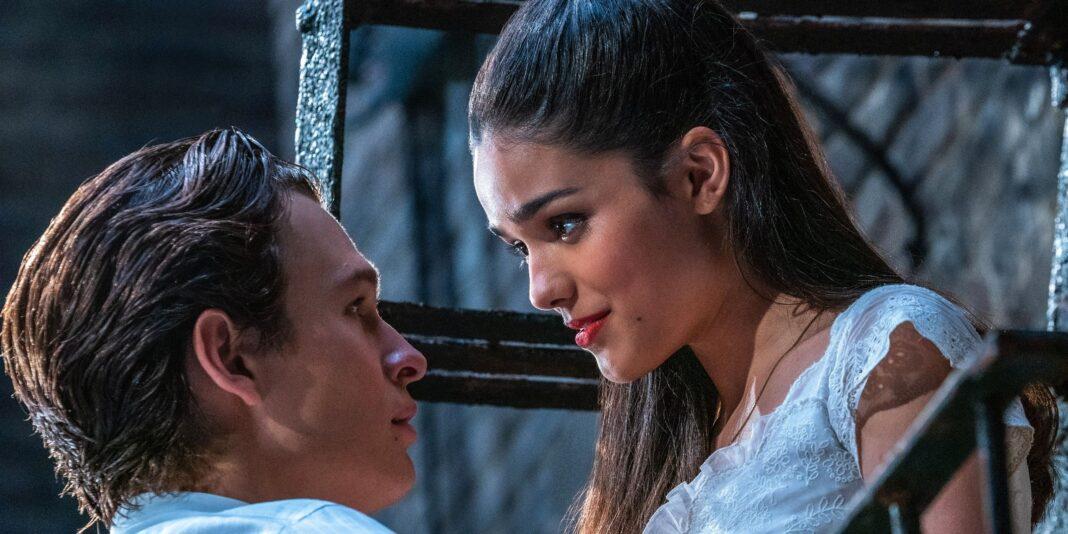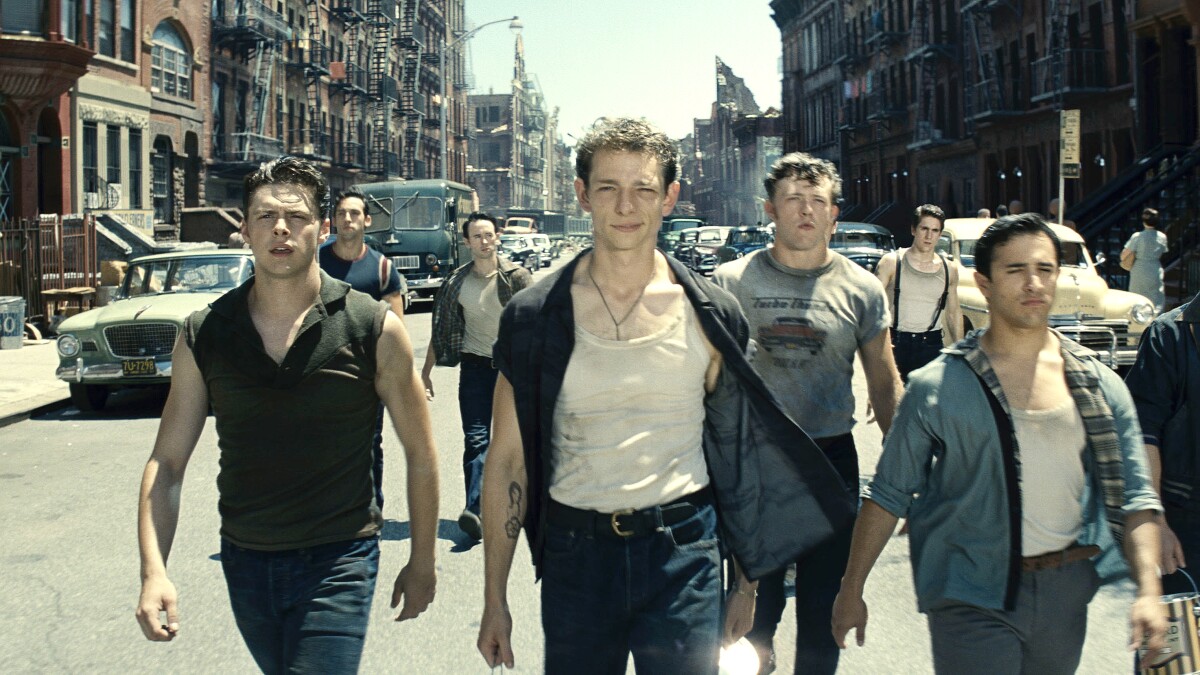Nothing beats a really well-done musical and you don’t really need to be a fan of Broadway to appreciate the different levels of artistry required to make one. A musical if done right showcases the culmination of storytelling in both prose and poetry/song form. There has been a slew of Broadway hits that have gotten their share of film adaptations in the past year alone such as Dear Evan Hansen, In the Heights, and tick, tick… BOOM!, just to name a few. The most recent amongst the bunch is the newest adaptation of the 1957 stage musical, West Side Story.
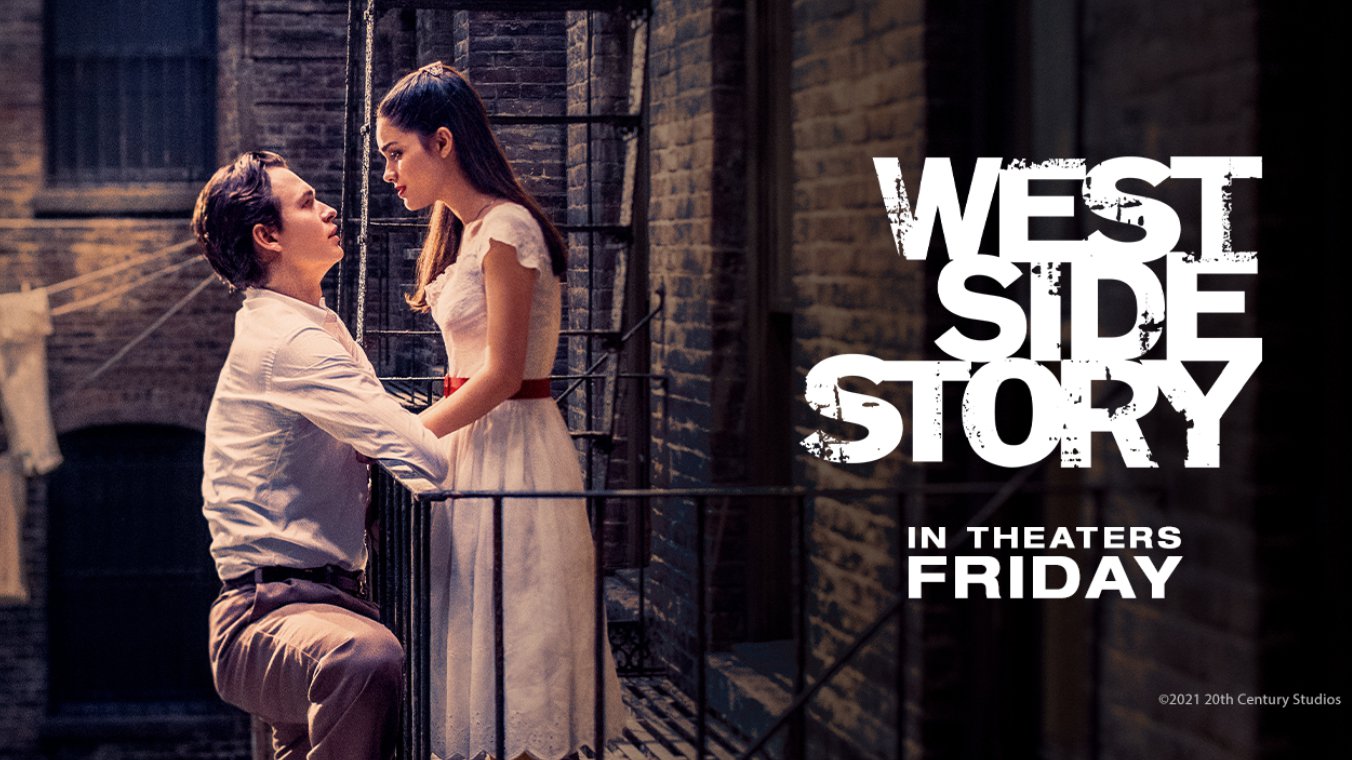
As mentioned this is the newest film adaptation for the musical after the 1961 film version which is regarded as one of the greatest musical films of all time. The inspiration behind the 1957 stage musical which in turn seeps into the film adaptations was Shakespeare’s play, Romeo and Juliet. The 1961 version was nominated for a total of 11 Academy Awards during that year while capturing a whopping total of 10 victories including Best Picture — in turn becoming the current record holder for the most awards for a musical film. With those accolades and records, it’s a huge question mark in mind, to be honest as to why anyone would want to recreate another film adaptation. It’s simply a Herculean task to do so.
No one could be any braver than one of the best directors of our time — Steven Spielberg. At the same time, if anyone could take a work of art such as this one and make it even better than it already has been, no one comes to my mind except Spielberg himself. Albeit, this isn’t up to his wheelhouse due to the absence of sci-fi elements, men in fedoras, and ravaging dinosaurs. No matter who it would be in the director’s chair or the make-up of the cast, the feat would still nonetheless be difficult.

The newest version of West Side Story however has garnered a total of 7 nominations in this year’s Academy Awards including one for Best Picture. These nominations alongside the huge names attached to the film and the sheer boldness to recreate an iconic film in film history definitely piqued our interest and was absolutely enough reason for us to check it out for ourselves to review.
A Brief Overview
For those who like me are unfamiliar with the original stage play and the 1961 film version, a little context on the story may be needed. As mentioned West Side Story is inspired by Shakespeare’s Romeo and Juliet, which immediately becomes evident in the first few moments of the film. Set in San Juan Hill on Manhattan’s West Side in New York City in 1957, two gangs — the Jets and the Puerto Rican Sharks fight over control of their turf. Tony, a young man in parole who is a part of the Jets, then falls in love with Maria, the younger sister of the leader of the Sharks. All hell breaks loose after their initial meeting as they juggle their forbidden love with the racism, societal divides, and personal struggles in surviving the harsh climates of their city. We also follow different key characters throughout the film and their struggles as they tie up to the central story between the Jets and the Sharks and between Maria and Tony.
West Side Story Review Spoiler Warnings
This review will limit its discussion to the disparities and improvements done onto the source materials, its cinematic and musical direction, and the themes and casting choices. This will not be an in-depth analysis of the songs or performances but I will touch slightly on their impact on the overall direction of the story which I believe is crucial to do so given its nature as a musical film.
Why Make Another Version?
As mentioned, the stakes are pretty high for this version of West Side Story as the bar has already been set pretty high. So how do you make improvements to a film that has already achieved so much? The key to this film was to create a more modern and even more relatable atmosphere. The story as an adaptation of Romeo and Juliet points to the timeless nature of West Side Story. The modernization of a classic literary piece has and will always resonate with people despite generational gaps. The elements and themes in this story are all the more pertinent and reoccurring today than ever. Therefore this is a story and message that will speak volumes in this generation and the next.
The release of this film once again in the 20th century is in itself a very powerful statement — one that is so heavy and hard to swallow at times. The film isn’t just about forbidden love but rather centers on the effects of the disparity of beliefs, appearances, and opportunity. West Side Story focuses more on the aftermath of conflicts between two groups of people who are fighting over for their pride and for a piece of land — land that has turned into a complete wasteland. These are two groups fighting over scraps of a society that belittles them and finds no true value in their worth. Given the contextualized setting of the 1950s and the release of the film in the 60s, and how it is still relevant and very much true in our world today speaks volumes about the harsh truth and conditions of our society. Five to six decades have changed nothing in terms of how we act and view people who are different from us. That is why making this film alone is in itself a powerful and eye-opening message for us all and one that will surely speak loudly for decades to come.
/cdn.vox-cdn.com/uploads/chorus_image/image/70516998/DF_12284_R3.0.jpg)
The utilization of a predominantly young cast who are just starting off in their careers was also a great enough reason to create a new version of West Side Story. We witness greatness in how each actor is able to draw out the best from their characters into their performances. We have a very naive yet strong-minded Maria portrayed by newcomer Rachel Zegler who shows no signs of inexperience. The one actor who has had some experience in various roles, Ansel Elgort, delivers a very restrained yet very strong-willed version of Tony who is caught in the crossfire of his stands of morality and the past that he heavily tries to escape. The clear standout in my opinion however is the musical veteran Ariana DeBose, known for a minor role in the musical, Hamilton. She is able to draw out the most in Anita both in her singing and dancing abilities and in the pure raw emotions that she pours out, especially in the later parts of the film. Overall the choices in the cast even with the ensemble are superb and are all very fitting and cohesive parts to complete West Side Story.
How To Top The Original?
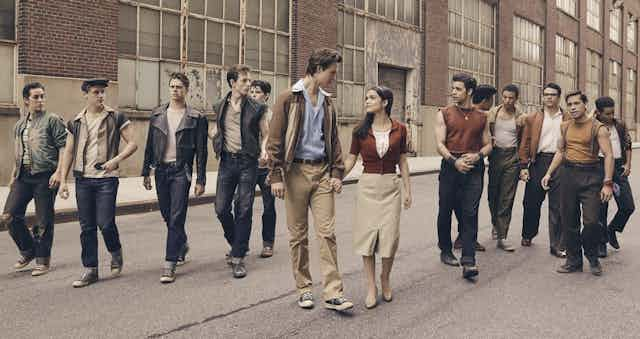
Retaining the original elements and flow of the first adaptation beats the need to create another adaptation. Spielberg needed to add more to his version and boy, did he? Grandeur. That is what this version provides. The set pieces had to be bigger. The choreography in the dance sequences had to be bolder. The message of the story had to provide a deeper sense of urgency. That’s what was brought to the table with this version of West Side Story. It’s a visual, auditory, and literary spectacle. The elements in cinematography and sound were amped up to a whole new level. Everything about this film was done to create a spectacle of an experience. For the most part, however, the film stayed more faithful to the original play production rather than the 1961 version but Spielberg made a few tweaks here and there to create a much more appealing visual masterpiece.

One of the elements that truly caught my attention with this version was the director’s vision for the inclusion and proper representation of the Latinx community. Of course, there are still some slight issues in truly providing such a culturally-appropriate atmosphere which were met with some disdain from Latino viewers but overall the director and producers did the most that they could in achieving such a goal. The most mind-blowing aspect was the utilization of Spanish dialogue. The cast chosen especially for the Sharks were from the Latino community to ensure fluency in speaking the language and for pure authenticity. The director however opted for a bold move to include Spanish dialogue without adding subtitles. Spielberg said that the decision to do so was “out of respect for the inclusivity of our intentions to hire a totally Lantix cast to play the Sharks’ boys and girls… If I subtitled the Spanish I’d simply be doubling down on the English and giving English the power over the Spanish. This was not going to happen in this film, I needed to respect the language enough not to subtitle it.” This was a powerful move as it enabled us viewers who aren’t fluent in the language to really zero in on the expressions, body movements, and tones in their voice to decode the Spanish conversations. This was done not to create a divide between those who can understand the language and those in the film but to really pay close attention and be involved to understand what is being said. It was a poetic gesture, involving us viewers into the same predicaments that the Jets felt at that time.
These small tweaks made all the difference to add flavor to already great source material. That’s where this film excels in reality. It’s attention to detail. Every element from the contrasts in colors and setting down to the choices in clothing, time of day for certain scenes, and grand set pieces were treated with so much care and precision that it is evidently clear how much thought and work was done even in the smallest of details and decisions.
Why A Musical?

This question might seem to have a very simple answer — because it’s the format of the source material. That may be true but it goes beyond that. There are different types of musicals; some a predominantly poetic with every conversation both internal and external done through songs like Les Miserables. This musical however creatively combines prose and poetry with each song and lyric being crucial to understanding the entire story. As viewers, we need to pay as much attention to the songs as we do with the dialogues and movements. And speaking of movements and choreography, there is just excellence in every dance and movement with again that attention to detail even with how their costumes flow and move along with every step. This was exceptionally seen in the performance of DeBose and the rest of the ensemble in the song America.
Every song also speaks volumes in communicating the deep and profound message of the story. The vocal abilities are on point but are further matched and enhanced by the on-point skills and gifting of Leonard Bernstein and Stephen Sondheim. The scoring is phenomenal and creates a mixture of beautiful sounds that showcase various influences from blues, jazz, croon, and of course, Latin sounds. The musical format adds a lot of depth to the story as it complements and brings in a more unified and artistic atmosphere to the story that nonetheless wouldn’t be achieved in simple prose format.
West Side Story Review Final Verdict

The newest film adaptation of West Side Story is as good or even better than the 1961 version. It’s hard to top the success of the first film but thanks to Spielberg, this more modern version definitely comes very close. It’s a movie that will surely continue the legacy of its predecessor, especially for a new generation to enjoy.
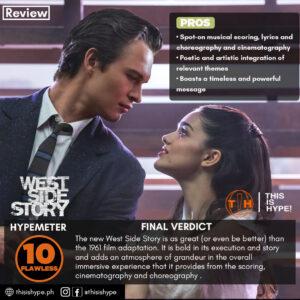
West Side Story in our books deserves a perfect score of 10 on our Hype Meter. It’s innovative, poetic, and has a message that isn’t only relevant but timeless at the same time. There’s more to it than what lies on the surface and isn’t just fun but cognitively and emotionally deep. You don’t need to be a fan of musicals to enjoy this one and in fact, you may just find yourself loving the genre all because of West Side Story.
For more movie reviews:
- A Spoiler-Free Spider-Man ‘No Way Home’ Review: All Roads Lead To This
- 007 No Time To Die Review: A Fitting Conclusion For Craig’s Bond?
- The King’s Man Review: A Unique Installment With Historical Roots
- Death on the Nile Review: A Worthy Sequel?
- The Batman Spoiler-Free Review: Stepping Out Of The Typical Superhero Tropes





















